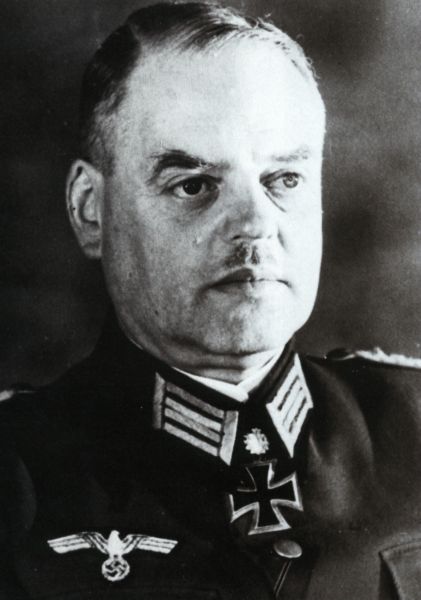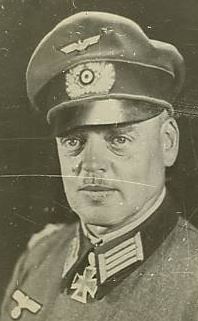Müller, von, Dietrich (Panzergrenadier-Regiment 5)
- Date of birth:
- September 16th, 1891 (Malchow/Mecklenburg-Schwerin, Germany)
- Date of death:
- January 3rd, 1961 (Hamburg, Germany)
- Nationality:
- German
Biography
Dietrich von Müller entered military service voluntarily in 1910 and was posted to Jäger-Regiment 3. After an employment of one year, he joined the Landwirtschaft.
At the outbreak of World War One, he was called in to Jäger-Regiment 3 as Fähnrich der Reserve (Cadet Reserve). Later in the war he became Leutnant of the Stab Landwehr-Inspizienten. (Home Defence Inspection?)
After the end of the first World War, von Müller started studying agricultural science. He enrolled in the Wehrmacht in 1934 and was posted to Infanterie-Regiment 5 with the rank of Hauptmann.
At the outbreak of World War Two, he served as Major and Chef II./Infanterie-Regiment 5. With this unit he took part in the campaigns against Poland and France; after the latter the unit was renamed Schützen-Regiment 5. From September 5th, 1941 onwards, he served as Kommandeur of this unit. July 10th, 1942, Müller’s regiment was transformed into Panzergrenadier-Regiment 5. After having been awarded the Eichenlaub, von Müller was made Leiter der taktischen Lehrgänge (head of tactical courses) on the Panzertruppenschule II (School for Armored troops) in Krampnitz. In addition he was posted to the Abteilungsführerschule (School of Department Leaders) in Paris and to the Stab des Inspekteurs der Panzerwaffe (Staff of the Inspector of Armored troops). In 1944 he was named Kommandeur 16.Panzer-Division.
On April 19th, 1945, Dietrich von Müller was made a prisoner of war by the Soviets after having been captured by Czech partizans. He was released from captivity in 1955.
Promotions:
?: Fähnrich der Reserve;
?: Leutnant;
?: Hauptmann;
April 1st, 1941: Oberstleutnant;
1942: Oberst;
November 9th, 1944: Generalmajor;
?: Generalleutnant.
Career:
1910: Jäger-Regiment 3;
?: Landwirtschaft;
1914: Jäger-Regiment 3;
?: Stab Landwehr-Inspizienten;
1934: Infanterie-Regiment 5;
1939: Chef II. / Infanterie-Regiment 5;
?: Chef II. / Schützen-Regiment 5;
September 5th, 1941: Kommandeur Schützen-Regiment 5;
July 10th, 1942: Kommandeur Panzergrenadier-Regiment 5;
?: Leiter der Taktischen Lehrgänge, Panzertruppenschule II, Krampnitz;
?: Abteilungsführerschule, Parijs;
?: Stab des Inspekteurs der Panzerwaffe;
August 14th, 1944 - March 1945: Kommandeur 16. Panzer-Division;
April 19th, 1945: Prisoner of war;
1955: Release
Do you have more information about this person? Inform us!
- Period:
- Second World War (1939-1945)
- Awarded on:
- September 19th, 1939
Had already received the Iron Cross 2nd Class on 2nd October 1914.
- Period:
- Second World War (1939-1945)
- Awarded on:
- October 31st, 1939
Had already received the Iron Cross 1st Class on 19th August 1916.
- Period:
- Second World War (1939-1945)
- Rank:
- Oberstleutnant (Lieutenant-colonel)
- Unit:
- Schützen-Regiment 5
- Awarded on:
- February 21st, 1942
Award 75/15.
- Period:
- Second World War (1939-1945)
- Rank:
- Oberstleutnant (Lieutenant-colonel)
- Unit:
- Kommandeur Schützen-Regiment 5 / 269. Infanterie-Division / XXVIII.Armee-Korps / 18.Armee / Heeresgruppe Nord
- Awarded on:
- May 3rd, 1942
982nd Award.
- Period:
- Second World War (1939-1945)
- Rank:
- Oberst (Colonel)
- Unit:
- Kommandeur Panzergrenadier-Regiment 5 / 12. Panzer-Division / 2.Panzer-Armee / Heeresgruppe Mitte
- Awarded on:
- August 16th, 1943
14.07.1943: Attack of the Panzergrenadier-Regiment 5 astride the Asarowo-Kornilowo road.
16.07.1943: The I./Pz.Gr.Rgt. 5 is encircled. Oberst von Müller manages to break through the encirclement ring with 2 Panzer IVs and an armoured car, and thereafter brings the Bataillon back into the main German frontline.
18.07.1943: 9 Soviet attacks are repulsed.
272nd Award.
- Period:
- Second World War (1939-1945)
- Rank:
- Generalmajor
- Unit:
- Kommandeur 16. Panzer-Division
- Awarded on:
- February 20th, 1945
134th Award.
Sources
- Photo 1: Wehrkundearchiv
- Photo: Deutsches Wehrkundearchiv
- - FELLGIEBEL, W.P., Elite of theThird Reich, Helion & Company Limited, Solihull, 2003.
- PATZWALL, K. & SCHERZER, V., Das Deutsche Kreuz 1941-1945, Verlag Klaus D. Patzwall, Norderstedt, 2001.
- THOMAS, FRANZ & WEGMANN, GÜNTER, Die Eichenlaubträger 1940-1945, Biblio-Verlag, 1998.
- Die Ordensträger der Deutschen Wehrmacht (CD), VMD-Verlag GmbH, Osnabrück, 2002
- Kwasny A., Kwasny G., Die Eichenlaubträger 1940-1945 (CD), Deutsches Wehrkundearchiv, Lage-Waddenhausen, 2001
- http://www.lexikon-der-wehrmacht.de









